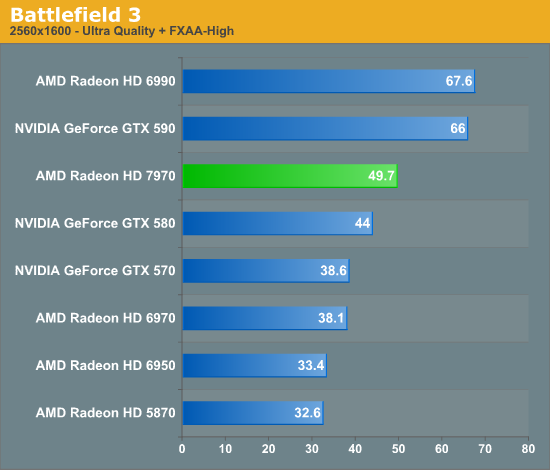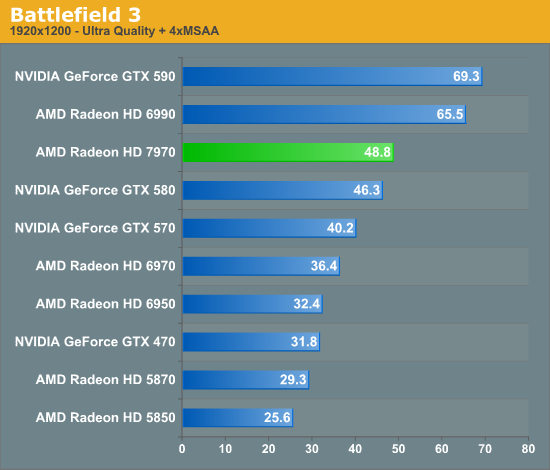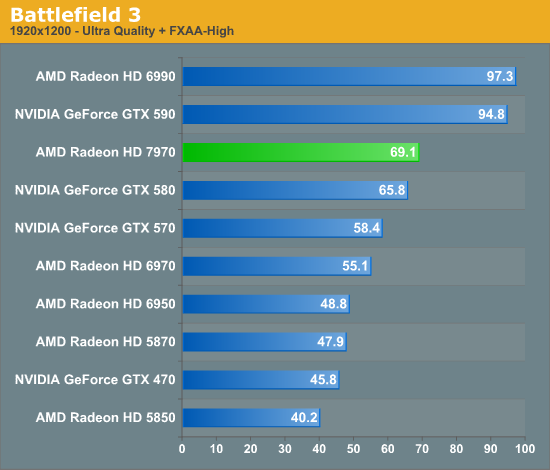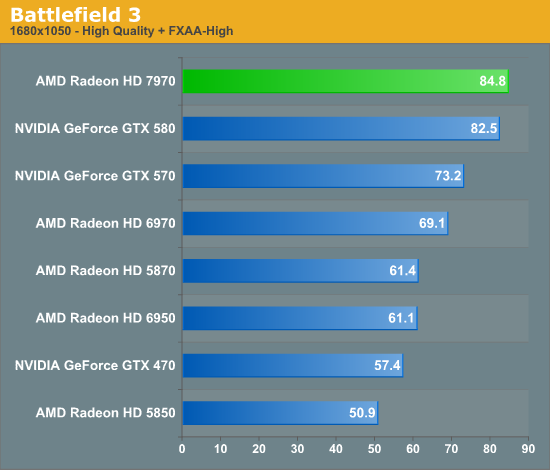AMD Radeon HD 7970 Review: 28nm And Graphics Core Next, Together As One
by Ryan Smith on December 22, 2011 12:00 AM EST- Posted in
- GPUs
- AMD
- Radeon
- ATI
- Radeon HD 7000
Battlefield 3
Its popularity aside, Battlefield 3 may be the most interesting game in our benchmark suite for a single reason: it’s the first AAA DX10+ game. It’s been 5 years since the launch of the first DX10 GPUs, and 3 whole process node shrinks later we’re finally to the point where games are using DX10’s functionality as a baseline rather than an addition. Not surprisingly BF3 is one of the best looking games in our suite, but as with past Battlefield games that beauty comes with a high performance cost




How to benchmark BF3 is a point of great contention. Our preference is to always stick to the scientific method, which means our tests need to be perfectly repeatable or very, very close. For that reason we’re using an on-rails section of the single player game, Thunder Run, to do our testing. This isn’t the most strenuous part of Battlefield 3 – multiplayer can get much worse – but it’s the most consistent part of the game. In general we’ve found that minimum framerates in multiplayer are about half of the average framerate in Thunder Run, so it’s important to frame your expectations accordingly.
With that out of the way, Battlefield 3 ends up being one of the worst games for the 7970 from a competitive standpoint. It always maintains a lead over the GTX 580, but the greatest lead is only 13% at 2560 without any MSAA, and everywhere else it’s 3-5%. Of course it goes without saying that realistically BF3 is only playable at 1920 (no MSAA) and below on any of the single-GPU cards in this lineup, so unfortunately for AMD it’s the 5% number that’s the most relevant.
Meanwhile compared to the 6970, the 7970’s performance gains are also a bit below average. 2560 and 1920 with MSAA are quite good at 30% and 34% respectively, but at 1920 without MSAA that’s only a 25% gain, which is one of the smaller gaps between the two cards throughout our entire test suite.
The big question of course is why are we only seeing such a limited lead from the 7970 here? BF3 implements a wide array of technologies so it’s hard to say for sure, but there is one thing we know they implement in the engine that only NVIDIA can use: Driver Command Lists, the same “secret sauce” that boosted NVIDIA’s Civilization V performance by so much last year. So it may be that NVIDIA’s DCL support is helping their performance here in BF3, much like it was in Civ V.
But in any case, this is probably the only benchmark that’s really under delivered for the 7970. 5% is still a performance improvement (and we’ll take it any day of the week), but this silences any reasonable hope of being able to use 1920 at Ultra settings with MSAA on a single-GPU card for the time being.










292 Comments
View All Comments
SlyNine - Friday, December 23, 2011 - link
Not really, If Nvidia didn't handicap the CPU version of physx so bad than I'd be fine with it, But Nvidia purposely made the CPU version of phsyx worse totally gimped.CeriseCogburn - Thursday, March 8, 2012 - link
I agree, but that's the way it guy. The amd fans don't care what they and their reviewers pull, and frankly the reviewers would recieve death threats if they didn't comply with amd fanboy demands....So when nvidia had ambient occlusion active for several generations back in a driver add, we were suddenly screamed at that shadows in games suck.... because of course amd didn't have that feature...
That's how the whole thing is set up - amd must be the abused underdog, nvidia must be the evil mis-implementer, until of course amd gets and actual win, or even any win even with 10% IQ performance cheat solidly in place, and any other things like failed AA, poor tessellation performance, no PhysX, etc, etc, etc...
We just must hate nvidia for being better and of course it's all nvidia's fault as they are keeping the poor red radeon down....
If amd radeon has " a perfectly circular algorithm " and it does absolutely nothing and even worse in all games, it is to be praised as an advantage anyway.... and that is still happening to this very day... we ignore shimmer until now, when amd 79xx has a fix for it.... etc..
Dude, that's the way it is man....
Nvidia is the evil, and they're keeping the radeon down...
They throw around money too ( that's unfair as well - and evil ...)
See?
So just pretend anything radeon cannot do that nvidia can doesn't count and is bad, and then make certain nvidia is cut down to radeon level, IQ cheat, no PhysX, AA not turned on, Tesselation turned down, default driver hacks left in place for amd, etc....
Then be sure to cheer when some price perf calc ignoring all the above shows a higher and or lower and card to have a few cents advantage... no free game included, no eyefinity cables... etc.
Just dude... amd = good / nvidia=evil ...
Cool ?
shin0bi272 - Thursday, December 22, 2011 - link
Since I cant edit my comments I have to post this in a second comment instead.According to the released info, Nvidia’s Next Gen flagship GK-100/GK-112 chip which will feature a total f 1024 Shaders (Cuda Cores), 128 texture units (TMUs), 64 ROP’s and a 512-bit GDDR5 Memory interface. The 28nm Next Gen beast would outperform the current Dual chip Geforce GTX590 GPU.
shaboinkin - Thursday, December 22, 2011 - link
Can someone tell me why GPUs tend to have much more transistors than a CPU? I never knew why.Boushh - Thursday, December 22, 2011 - link
Basically it has to do with the difference between programs (= CPU instructions) and graphics (= pixels):A program consists of CPU intructions, many of these instructions depend on output from the previous instruction, Therefore adding more pipelines that can work on the instructions doen't realy work.
A picture consists of pixels, these can be processed in parrallel. So if you double the number of pipelines (= pixels you can work on at the same time), you double the performance.
Therefore CPU's don't have that many transistors. In fact, most transistors in a CPU are in the cache memory not in the actual CPU cores. And GPU's do.
Of course this is hust a simple explenation, the through is much much more complex ;-)
Boushh - Thursday, December 22, 2011 - link
That last line should read:'Of course this is just a simple explanation, the reality is much much more complex'
Reminds me to yet again vote for an EDIT button !!!! Maybe as a christmas present ? PLEASE !!!
shaboinkin - Thursday, December 22, 2011 - link
Interesting...Do you know of a site that goes into the finer details?
Mishera - Wednesday, December 28, 2011 - link
If you're looking for something to specifically answer you question the checking different tech sites. I think realworldtech addressed tis to a degree. Jon Stokes at arstechnica from what I heard wrote some pretty good articles on chip design as well. But if it's a question on chip architecture, reading some textbooks is your best bet. I asked a similar question in the forums before and got some great responses just check my posts.I add to what Boushh said in that for the type of information they process, it's beneficial to have more performance (and not just for graphics). That's why Amd has been pushing to integrate the gpu into the CPU. That's also to a degree show the different philosophy right now between intel and Amd in multicore computing (or the difference between Amd's new gpu architecture vs their previous one).
What it comes down to is optimizing chip design to make use of programs, vice versa. There really is now absolute when dealing with this.
MrSpadge - Thursday, December 22, 2011 - link
It's not like - as stated several times in the article - AMD is wrong about the power target of the HD7970, if they mean the PowerTune limit. Think of it as "the card is built to handle this much heat, and is guaranteed not to exceed it". That doesn't forbid drawing less power. And that's exactly what the HD6970 does: it's got the same "power target", but it uses less of its power budget than the HD7970.Like CPUs, whose real world power consumption is often much less than the TDP.
MrS
Ryan Smith - Thursday, December 22, 2011 - link
PowerTune is a hard cap on power consumption. Given a sufficient workload (i.e. FurMark or OCCT), you can make the card try to consume more power than it is allowed, at which point PowerTune kicks in. Or to put this another way, PowerTune doesn't kick in unless the card is at its limit.PowerTune kicked in for both the 6970 and 7970. In which case both cards should have be limited to 250W.